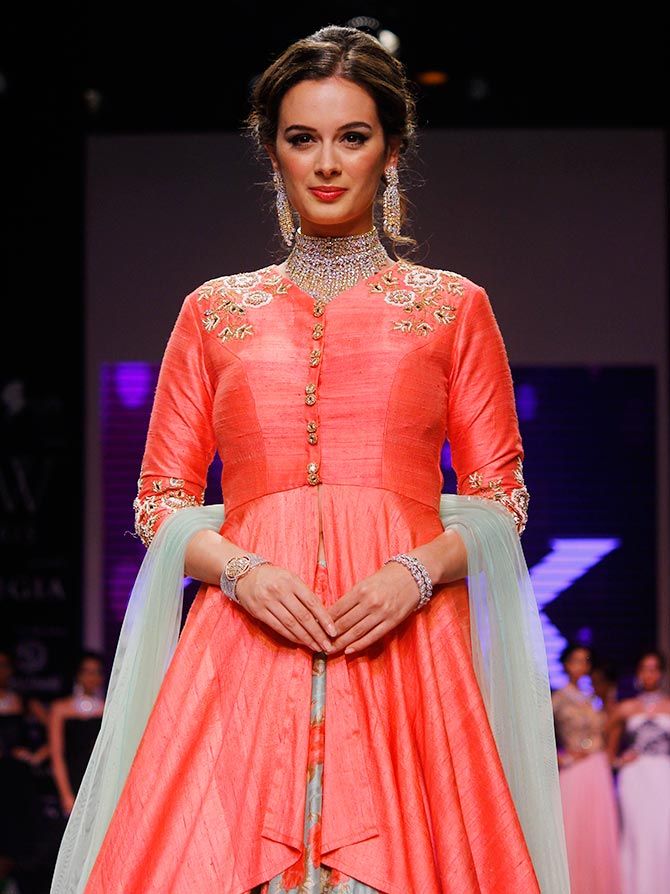'I'm a fashion philanthropist, but people are wondering how she can still be doing a song in a bikini.'
'When a woman becomes a philanthropist, it is always expected that she must be like a Mother Teresa kind of a girl.'
'Why would I become like anyone else?'

An actress do-gooder?
Now that's rare, isn't it?
Meet actress Evelyn Sharma, who is trying to provide clothes to the needy through her NGO Seams For Dreams.
Evelyn tells Rediff.com's Anita Aikara how she plans to provide clothes to 100,000 needy people in 2016.

Photograph: Hitesh Harisinghani/Rediff.com
From actress to the founder of Seams For Dreams! That's quite a transformation...
Charity has always been something very close to my heart. From the time I was a teenager, I always dreamed of having my own charity foundation.
After college, I worked for a whole year in charity foundations around Europe.
When I came to India (Evelyn is half-Indian), I felt very strongly towards my country.
I wanted to give back in any way I could.
When I became more popular and had fans who found inspiration in what I did (on social media), I decided it was the right time to start my charity foundation.
Because my image has always been that of a fashionista -- and as an actor in Bollywood, it is always about fashion -- I decided to start a charity foundation around fashion.
What is Seams For Dreams about?
Combining fashion and charity, we just wanted to touch upon what everyone loves the most -- fashion -- and use that to give back, which we're doing by our mission of clothing people in need. The charitable foundation is one-year-old.
In the first year, we were able to clothe around 4,000 people. In the second year our target is to clothe over 100,000.
That basically happens when people's old kurtas, jeans, T-shirts, which are donated to us, go to people in need.
With the high-end outfits, which are of no use to people in need like lehengas, party outfits, etc, we do fundraising events like garage sales.
To make it more interesting, we always ask celebrities and designers to give some interesting pieces -- from custom-made gowns to fun, item-song and stage costumes.
How do you find these needy people?
Our focus for the first year was obviously Bombay (Mumbai). We are not that big a charity foundation yet.
But we have tie-ups with other NGOs around India where we send our clothing for people to use (after knowing exactly what they need).
We have donated our clothes to people living in the outskirts of Mumbai -- like Badlapur, for different causes -- like girls who were rescued from trafficking.
We have also provided clothing for children in Jaipur, who were rescued from child labour and put into schools.
We try and give wherever there is an urgent need, for example when floods or earthquakes happen.
Our main focus is, of course, our neighbourhood -- people living right next to us. Mumbai has one of the biggest slums in the world. There is always someone who needs a pair of shoes or clothes.
Around winter we were able to provide clothes to the needy. Most of us don't know how many people die around us due to the cold in winter.
How do you ensure that the clothes go into the right hands?
We want to make sure that everything that goes out, goes into the right hands. Whenever you donate clothes or we do a fundraising event, it always goes up on our Web site.
Several friends ask me, 'Should we give you the clothes or should we give it to our maids or the orphanage/church next to my house?'
I think it's best to give your old clothes to 2 to 3 people rather than giving just one person 15 clothes!
Often when people get too many clothes they end lending or selling it.
I keep telling people to give the clothes to us and also ask them (orphanages) to come to us. Because you may think you have clothing that will fit into the orphanage, but what if it is not appropriate.
When we donate, we talk with the people and get to know what they exactly need.
It is important to provide the right type of clothing that the person requires rather than overloading them with more clothes.

Photograph: Hitesh Harisinghani/Rediff.com
Where do you store the donated clothes?
I have an office with a little storage. But I don't believe in storing clothes. As soon as we get clothes, we try and find someone whom we can give the clothes to.
We have a couple of partner NGOs across India, so whenever we get the clothes, we immediately call our partner NGOs and find out if they need anything.
NGOs that go into rural India, usually go with a truck of clothing and they hand out one set (of clothing) per person, who they feel is in need of it.
Or they go into the red light district and then distribute the clothes.
What do you do with clothes you cannot use?
We get a lot of scrap clothes. So we have started up-cycling clothes. We make new clothes out of old ones. We have tied up with several fashion schools across Mumbai and we give them different projects.
We want the whole fashion industry to be involved. We don't want to be a boring NGO that does their own work; we want everyone to be inspired by us.
Is there a market for second-hand clothing in India?
We are pretty much the pioneers when it comes to vintage and second-hand clothing. One year later, after we started off with our first garage sales, vintage boutiques are opening up.
We want to create awareness that wearing second-hand clothing is amazing. It is actually much cleaner than you think.
When you go to a shop, you think the clothing is clean, because you are buying new clothes.
But what you are not aware of is how many toxins are in these clothes carry or how they are chemically treated with colours. Second-hand clothing is super clean because it has been washed many times.
How far are you from reaching your goal this year?
This year we want to collect 100,000 clothes. I believe in going slowly, but being steady, step by step.
We are just in the second year. I think we have already reached our goals by getting everyone involved.
I cannot believe the love we have got from the fashion industry -- almost every designer has donated something. Pretty much all my celebrity friends, co-actors I have worked with have given one-two pieces.
The fashion schools are super excited with this upcycling trend. I am so happy already.

Photograph: Kind Courtesy Evelyn Sharma/Instagram
Other issues close to your heart...
In India, there are so many things that I can talk about!
One thing that is really close to my heart is woman rights. There're so many double standards in our world.
What I face is that I'm a fashion philanthropist, but at the same time people are wondering how she can still be doing a song in a bikini.
For people it is like two different things and they do not understand that you can be a hot philanthropist as well.
When you're a woman who gives back, you don't need to wear a kurta and an aunty-type dress. You can still be hot and young. I am not 60 years old!
This double standard will only go when women are more equal (to men).
When a woman becomes a philanthropist, it is always (expected) that she must be like a Mother Teresa kind of a girl. Why would I become like anyone else?
If you want to contribute towards the cause, log on to https://seamsfordreams.com/ for more information.
You can also call on +91 22 6146 4020 or e-mail at info@seamsfordreams.com.










